
That first traversal from one planet to another is utterly joyous, an entirely seamless and silky smooth experience that even the mighty Elite Dangerous couldn’t quite manage. It’s something I’ve wanted to do in a game since I was about ten years old, and that No Man’s Sky finally achieves it means that, no matter what else I think of it, it will always have a special place in my heart. Incidentally, travelling between systems via hyperjump is less fluid. The kaleidoscopic shimmer of hyperspace obviously conceals a loading screen. But this could hardly be considered a problem.
The true nature of any given planet is hidden to you until the moment you breach the atmosphere. It’s possible to glean clues from the colour of the planet (if it has a blue-tint, chances are it’s a water or ice planet), but the composition of the surface is nearly always a surprise. Rarely, though, is it anything less than stunning. Even the most barren of moons is frequently home to strange rock formations that loop and twist across the surfaces like an unravelled ball of wool, or eerie cuboid obelisks that bring to mind films like Alien and Prometheus (in a good way). More verdant planets might offer forests of giant cacti or mushrooms, whilst being populated by all manner of strange creatures, from scuttling, crab-like beasts, to gigantic, dinosaur-esque monstrosities.
The way the game’s animals are procedurally generated has come under a bit of fire for producing Spore-like mongrels. It’s true that sometimes you’ll stumble across what is basically a cow with the head of a T-Rex. But it’s equally possible you’ll discover a species that looks genuinely extra-terrestrial. On one planet, I spotted a floating jellyfish-like creature with such a terrifying silhouette I never worked up the courage to take a closer look. On another, I found a deer-like creature with tentacles protruding from the top of its neck.
As is always the case with games that place a heavy emphasis on procedural generation, patterns inevitably start to emerge. You’ll come to recognise a paradise world or a desert planet within moments of viewing the surface. Nevertheless, each one remains remarkably diverse, and although the wonder at first encountering a new world might lessen, it never fully dissipates. This is aided by the fact that the differences stem beyond aesthetics and aliens. One planet I landed on was so intensely radioactive I couldn’t stay outside for longer than a minute. Another was labelled as a 'high-security planet', which meant the mysterious sentinels that patrol all the game’s worlds were programmed to shoot on sight.
It's the allure of discovery, the chance that the next planet might hide some incredible secret, that keeps No Man’s Sky ticking over. Of course, the opportunity for thrilling discoveries also means there’s a good chance you’ll encounter far more mundane worlds. It’s when this happens that the flaws of No Man’s Sky begin to reveal themselves.
While the variety of worlds on offer verge on infinite, the core loop at the centre of the game is considerably more finite. The variety of unique locales on each planet is limited to around a couple of dozen, ranging from trading posts to crashed ships to alien ruins and abandoned colonies. These might sound exciting, and when you first stumble across them, they absolutely are. But within a few hours the repetition of these elements really starts to grate. It’s a shame that the same procedural magic hasn’t been applied to the game’s interiors and architecture of the game. Having sprawling ruins and derelict sci-fi complexes to delve into would help to ease this sense of repetition.
In fact, I’m surprised that the developers haven’t focussed completely on the concept of discovery for the more central game systems, particularly when it comes to finding new equipment and upgrading your ship. It is part of the way there – uploading the new planets and species you’ve discovered earns you in-game currency, and lets you assign a name to said discoveries, but a Borderlands-style system where you’re scavenging alien worlds of equipment from shipwrecks and lost civilisations would fit No Man’s Sky like a jumpsuit.
The true nature of any given planet is hidden to you until the moment you breach the atmosphere. It’s possible to glean clues from the colour of the planet (if it has a blue-tint, chances are it’s a water or ice planet), but the composition of the surface is nearly always a surprise. Rarely, though, is it anything less than stunning. Even the most barren of moons is frequently home to strange rock formations that loop and twist across the surfaces like an unravelled ball of wool, or eerie cuboid obelisks that bring to mind films like Alien and Prometheus (in a good way). More verdant planets might offer forests of giant cacti or mushrooms, whilst being populated by all manner of strange creatures, from scuttling, crab-like beasts, to gigantic, dinosaur-esque monstrosities.
The way the game’s animals are procedurally generated has come under a bit of fire for producing Spore-like mongrels. It’s true that sometimes you’ll stumble across what is basically a cow with the head of a T-Rex. But it’s equally possible you’ll discover a species that looks genuinely extra-terrestrial. On one planet, I spotted a floating jellyfish-like creature with such a terrifying silhouette I never worked up the courage to take a closer look. On another, I found a deer-like creature with tentacles protruding from the top of its neck.
As is always the case with games that place a heavy emphasis on procedural generation, patterns inevitably start to emerge. You’ll come to recognise a paradise world or a desert planet within moments of viewing the surface. Nevertheless, each one remains remarkably diverse, and although the wonder at first encountering a new world might lessen, it never fully dissipates. This is aided by the fact that the differences stem beyond aesthetics and aliens. One planet I landed on was so intensely radioactive I couldn’t stay outside for longer than a minute. Another was labelled as a 'high-security planet', which meant the mysterious sentinels that patrol all the game’s worlds were programmed to shoot on sight.
It's the allure of discovery, the chance that the next planet might hide some incredible secret, that keeps No Man’s Sky ticking over. Of course, the opportunity for thrilling discoveries also means there’s a good chance you’ll encounter far more mundane worlds. It’s when this happens that the flaws of No Man’s Sky begin to reveal themselves.
While the variety of worlds on offer verge on infinite, the core loop at the centre of the game is considerably more finite. The variety of unique locales on each planet is limited to around a couple of dozen, ranging from trading posts to crashed ships to alien ruins and abandoned colonies. These might sound exciting, and when you first stumble across them, they absolutely are. But within a few hours the repetition of these elements really starts to grate. It’s a shame that the same procedural magic hasn’t been applied to the game’s interiors and architecture of the game. Having sprawling ruins and derelict sci-fi complexes to delve into would help to ease this sense of repetition.
In fact, I’m surprised that the developers haven’t focussed completely on the concept of discovery for the more central game systems, particularly when it comes to finding new equipment and upgrading your ship. It is part of the way there – uploading the new planets and species you’ve discovered earns you in-game currency, and lets you assign a name to said discoveries, but a Borderlands-style system where you’re scavenging alien worlds of equipment from shipwrecks and lost civilisations would fit No Man’s Sky like a jumpsuit.

MSI MPG Velox 100R Chassis Review
October 14 2021 | 15:04

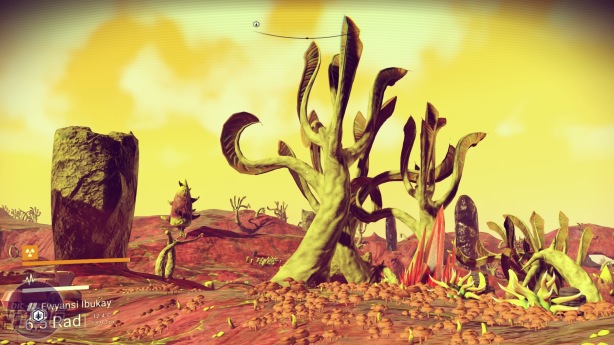
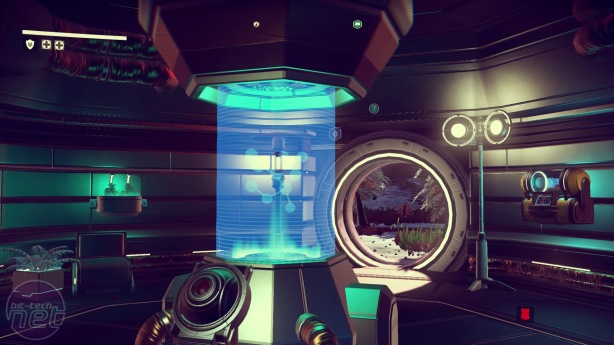

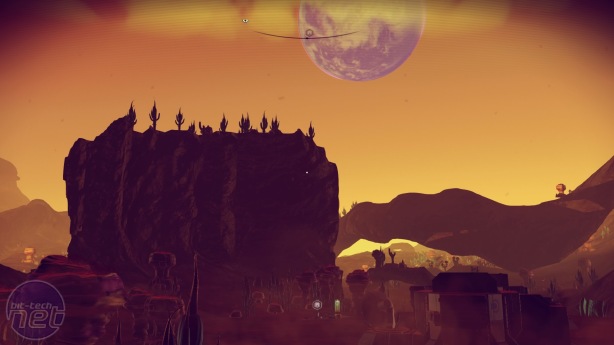
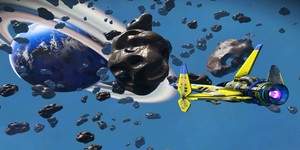
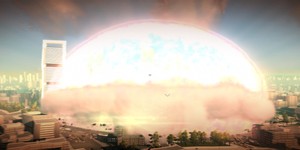
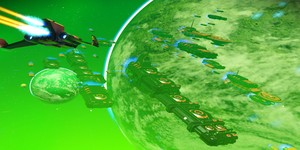





Want to comment? Please log in.